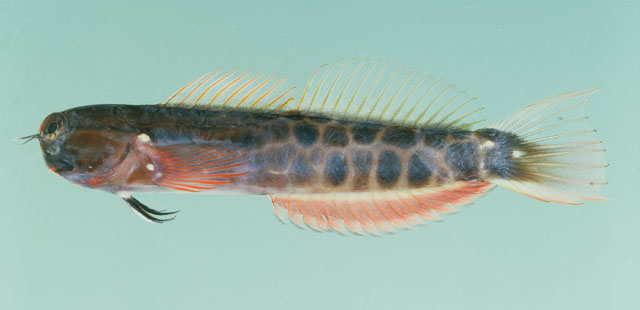| Blenniidae (Combtooth blennies), subfamily: Salariinae |
| 4.5 cm SL (male/unsexed) |
|
reef-associated; marine; depth range 6 - 10 m |
| Western Pacific: New Caledonia and New Hebrides (Vanuatu). |
|
Dorsal spines (total): 12-12; Dorsal soft rays (total): 14-15; Anal spines: 2-2; Anal soft rays: 16-17; Vertebrae: 33-33. Dorsal fin XII.14 or 15, with deep notch between spinous and segmented-ray portions. Anal fin II,16 or 17. Pectoral fin 13. Segmented caudal-fin rays 13. Vertebrae 10 + 23. Dentary incisor teeth 50-54 which includes anterior canine teeth very similar in appearance with incisors; posterior canines 1 on each side. Lateral line without vertical pairs of pores, terminating posteriorly at some point between vertical from interspace between dorsal-fin spines 10 and 11and vertical from first segmented ray. With cirrus on posterior rim of anterior nostril; absent on anterior rim. Dark spots on posterior half of body tile-like, surrounded and separated from each other only by pale, grout-like (interconnected) network (Ref. 5296). |
| Oviparous. Eggs are demersal and adhesive (Ref. 205), and are attached to the substrate via a filamentous, adhesive pad or pedestal (Ref. 94114). Larvae are planktonic, often found in shallow, coastal waters (Ref. 94114). |
|
Least Concern (LC); Date assessed: 25 March 2009 Ref. (130435)
|
| harmless |
Source and more info: www.fishbase.org. For personal, classroom, and other internal use only. Not for publication.
